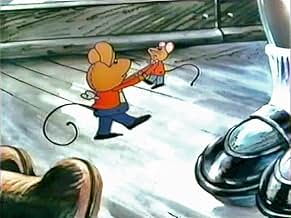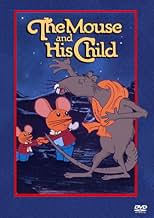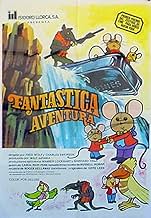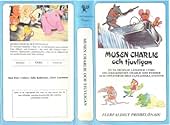अपनी भाषा में प्लॉट जोड़ेंAdaptation of Russell Hoban's novel about two mechanical toy mice, and their quest to become "self-winding".Adaptation of Russell Hoban's novel about two mechanical toy mice, and their quest to become "self-winding".Adaptation of Russell Hoban's novel about two mechanical toy mice, and their quest to become "self-winding".
- निर्देशक
- लेखक
- स्टार
Cloris Leachman
- Euterpe
- (वॉइस)
Sally Kellerman
- The Seal
- (वॉइस)
Andy Devine
- The Frog
- (वॉइस)
Alan Barzman
- The Mouse
- (वॉइस)
John Carradine
- The Tramp
- (वॉइस)
Neville Brand
- Iggy
- (वॉइस)
Regis Cordic
- The Clock
- (वॉइस)
Joan Gerber
- The Elephant
- (वॉइस)
Maitzi Morgan
- Teller
- (वॉइस)
- …
Frank Nelson
- Crow #1
- (वॉइस)
Cliff Norton
- Crow #2
- (वॉइस)
Iris Rainer
- Paper People
- (वॉइस)
- …
Robert Ridgely
- Jack in the Box
- (वॉइस)
- (as Bob Ridgely)
फ़ीचर्ड समीक्षाएं
I aquired my own copy of "the Mouse and His Child" from a video store that (go figure) was just going to throw it away. I hadn't seen it in many years but I did remember it as being good.
Well, memory served me well, but not in the way I'd expected!
I can see why the store was so desperate to get rid of this one. Aparently, these days, you aren't going to make it in the Family section (and this really belongs in with the anime and the Bakshi) if you're quiet and introspective. This is one of the heaviest animated films ever made, but I admire it for that. Check it out, if you're able to.
What, you've never seen a cartoon where the characters contemplate infinity?
Well, memory served me well, but not in the way I'd expected!
I can see why the store was so desperate to get rid of this one. Aparently, these days, you aren't going to make it in the Family section (and this really belongs in with the anime and the Bakshi) if you're quiet and introspective. This is one of the heaviest animated films ever made, but I admire it for that. Check it out, if you're able to.
What, you've never seen a cartoon where the characters contemplate infinity?
This movie helped me along the path to liking stories with more than talking animals and large Disney Musical Productions, though there's a place for those in my viewing. This movie led me to un-childish series (mostly Japanese) with deep meanings and messages. Deep as Akira (though more comprehensible) and just as dark, this story tells about a toy "family" and a toy child's desperate wish for the family to find itself again and stay together despite cruel enemies and crueler friends. Having read the book again recently, it seems that stories Such as "Toy Story" and "A.I. Artificial Intelligence" took a little from this story's soul.
1977's "The Extraordinary Adventures of the Mouse and His Child" was coproduced in Hollywood by the Japanese greeting card company Sanrio, lasting a full year on a budget of $1.5 million. Russell Hoban's 1967 novel proved a difficult subject for what was advertised as a children's animated feature, confirmed by its dismal box office take as a perceived BOMB (as Leonard Maltin casually dismissed it). While the animation itself leaves much to be desired, the story remained faithful to its source and many viewers from a very young age could not forget the lessons gleaned from their long ago acquaintance. We open on a tramp with a barking dog looking through the window of McMacken's Toys to see a clockwork father mouse marching while holding his son in the air, their predetermined fate to repeat this same action every time their owner winds them up through the key in the father's back. The other toys scoff at the child mouse's wish for them all to remain a family unit, only for father and son to fall off the shelf and wind up at the dumpster, where the aforementioned tramp (the distinctive tones of venerable John Carradine) repairs the damage, winds them up, and watches them walk away to an uncertain future with but two words: "be tramps!" Top billed Peter Ustinov has a field day with Manny the Rat, putting toys like them to work as slave labor for his rodent army, not expecting these two mice to escape with the help of Andy Devine's psychic Frog (the final role for the rotund actor with the gravelly voice). The only way that the mouse and his child can be free is to become 'self winding,' thus self reliant and able to cope in a world of infinite dangers, rather than discarded when no longer needed like so many more deserving toys. The climax finds Manny earning his comeuppance and Carradine's tramp surveying things with the last two words: "be happy." The central characters are actually its weakest link, they move from one incident to the next without complaint and let others handle the rough stuff. The drab, cheerless colors are poorly realized, perhaps deliberately, ably invoking a gloomy atmosphere that still managed to sear itself into many childhood memories. Despite special billing and with only four words to speak, John Carradine fans may be forgiven to find their hero ill used, but another animated part loomed on the horizon conceived in his own arthritic image, 1982's "The Secret of NIMH," while his first such feature, "Shinbone Alley," was an adult item from 1969 that also suffered a similar disappointing fate in cinemas and still remains unappreciated. Other vocal talent on hand include Cloris Leachman, Sally Kellerman, Neville Brand, and Jack Benny sidekick Frank Nelson, all very impressive for a title that has only been issued on VHS in the US.
THE MOUSE AND HIS CHILD is a symbolic study of human suffering that apparently was palmed off as a kiddie cartoon feature because of it's characters(A clockwork toy mouse and his son).This film, however, has very little that recommends it as a typical children's cartoon--it's dark, with somber colors, no chirpy songs, no silly sidekicks or lame comedy. The mouse and his child fall from the safety of their toy store window and are cast out with the garbage, after which they roam around the outside world, looking to be "self-winding". Along the way they encounter various nefarious characters, including a rat who exploits worn-out toys by forcing them to labor for him hauling scavenged items from the garbage. See the symbolism yet? I didn't when I first saw this thing when I was six, but, in regard to the reviewer who wondered if children would "get" this movie, I can say that I felt sadness for these two little toy mice, struggling to find their way in a cruel world, and wondered if they would ever be safe. I knew that the rat was the bad guy, and that the mice would have to escape him if they were to find what they wanted. There's nothing here that I believe would disturb a child, it's grim tone won't endear the movie to most families. While children might not understand the symbolic signifigance of all they see, they can understand the mice's need to belong and be happy, which is what the film is about. Try this film if you sicken from the sugar supplied by the recent Disney offerings; this one offers substantial food for thought
7tavm
After 30 years of knowing about this non-Disney animated feature, I finally decided to watch The Mouse and His Child on YouTube. The animation is both haunting and beautiful in many places. The characters are appealing when they concern the "wind-ups" and some forest animals and suitably creepy when displaying most of the rats. The story seems simple but some characters go on tangents about life that threatens to become pretentious after a while though that happens only for a few minutes. Not much of humor happens here though it was amusing hearing Frank Nelson as a crow, Andy Devine (in his last role) as a frog, and Cloris Leachman as, I think, a bird. I was pleasantly surprised to see in the end credits that of Charles Schulz Creative Associates as one of the companies involved. Oh, and one of the wonderfully weirdest scenes involved seeing the Bosco can show the dog posed with a picture of him looking the same in position ad infinitum (to illustrate infinity). On that note, I guess that's a recommendation for The Mouse and His Child.
क्या आपको पता है
- ट्रिवियाSir Peter Ustinov (Manny the Rat) and Andy Devine (The Frog) also did voice work for Disney's रॉबिन हुड (1973), in which Ustinov voiced Prince John and King Richard, and Devine voiced Friar Tuck.
- गूफ़During the spring when an insane Manny shows up and uses a rock to smash the two toy mice, he isn't wearing his scarf, most likely due to the season change, and his tail was briefly missing when he cowers at the sight and aftermath of the damage he did to the toys. They both reappeared later of in his next scene when he and the other rats invade the dollhouse.
- भाव
The Mouse Child: Papa, I'm afraid! I wanna go home! What's gonna happen to us?
The Mouse: Well, something good, son, as easily as something else. Why, anything can happen.
Manny the Rat: But it won't! Not this evening, my lads!
- क्रेज़ी क्रेडिटIn the Japanese release, the closing credits are altered and feature pictures of characters from the film, which are shown alongside the text on multi-colored backgrounds.
- इसके अलावा अन्य वर्जनThe American release has closing credits simply displayed against a pink background. However, the Japanese release has alternative closing credits with images of characters (see Crazy Credits).
टॉप पसंद
रेटिंग देने के लिए साइन-इन करें और वैयक्तिकृत सुझावों के लिए वॉचलिस्ट करें
- How long is The Mouse and His Child?Alexa द्वारा संचालित
विवरण
- रिलीज़ की तारीख़
- कंट्री ऑफ़ ओरिजिन
- आधिकारिक साइट
- भाषा
- इस रूप में भी जाना जाता है
- The Extraordinary Adventures of the Mouse and His Child
- उत्पादन कंपनियां
- IMDbPro पर और कंपनी क्रेडिट देखें
इस पेज में योगदान दें
किसी बदलाव का सुझाव दें या अनुपलब्ध कॉन्टेंट जोड़ें

















